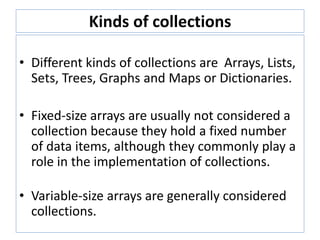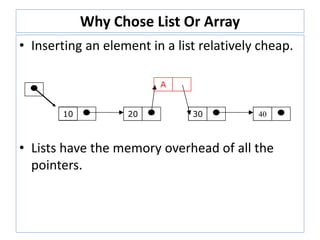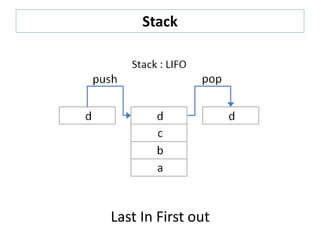This document provides an overview of collections in computer science and Python. It defines a collection as a grouping of variable data items that need to be operated on together. Collections include common data structures like arrays, lists, sets, trees and graphs. In Python, built-in collection types include lists, sets, dictionaries and tuples, while the collections module provides additional types like deque. The document discusses lists and arrays in detail, covering how to access and modify elements, basic operations, and when each type is best suited depending on the needs of the problem.






![Lists – indexed access
A sequence of memory positions that can be used to store elements.
# declare a variable myList of type List populated with elements 10 to 50
myList = [10, 20, 30, 40, 50]
# Can access the elements using an index.
print myList[3]
40
# Index position starts at zero.
print myList[0]
10
myList 10 20 30 40 50
index 0 1 2 3 4](https://image.slidesharecdn.com/blti-160206082319/85/Brixon-Library-Technology-Initiative-7-320.jpg)
![Lists – indexed access
# Can use a variable to index elements in the array or list
index = 4
print myList [ index ]
50
# A access from the end using negative index
print myList [-1]
50
print myList[-3]
30
myList 10 20 30 40 50
index 0 1 2 3 4
-5 -4 -3 -2 -1](https://image.slidesharecdn.com/blti-160206082319/85/Brixon-Library-Technology-Initiative-8-320.jpg)
![Lists – index out of range
# We get an IndexError when we try to index out of bounds
myList = [10, 20, 30, 40, 50]
print myList[ 20 ]
IndexError: list index out of range](https://image.slidesharecdn.com/blti-160206082319/85/Brixon-Library-Technology-Initiative-9-320.jpg)
![Lists - slices
# Lists can be accessed using a ‘slice’
myList = [10, 20, 30, 40, 50]
# myList[ start : until ] UNTIL is not included
print myList [ 1 : 4 ]
[20,30,40]
# You can omit implied start and until
print myList [ : 4 ]
[10,20,30,40]
print myList [ 2 : ]
[30, 40, 50]](https://image.slidesharecdn.com/blti-160206082319/85/Brixon-Library-Technology-Initiative-10-320.jpg)
![Lists - slices
# A slice can be defined in steps
myList = [10, 20, 30, 40, 50]
# myList[ start : until : step ]
print myList [ 1 : 4 : 2 ]
[20,40]
# With implied values for start and end
print myList [ : : 2]
[10, 30, 50]
print myList [ : : 3]
[10, 40]](https://image.slidesharecdn.com/blti-160206082319/85/Brixon-Library-Technology-Initiative-11-320.jpg)
![Lists – assignment to slices
myList = [10,20,30,40,50]
# replace some values
myList[2:4] = ['C', 'D', 'E']
print myList
[10, 20, 'C', 'D', 'E', 50]
# now remove them by assigning an empty list to the same positions
myList[2:5] = []
print myList
[10, 20, 50]
# clear the list by replacing all the elements with an empty list
myList[:] = []
print myList
[]](https://image.slidesharecdn.com/blti-160206082319/85/Brixon-Library-Technology-Initiative-12-320.jpg)
![Lists – Strings
# Strings are treated as a list
name = "Felix The House Cat“
print name[2:5]
'lix'
# Strings are immutable – you cannot change them :
name[2:5] = "CAN NOT DO THIS"
TypeError: 'str' object does not support item assignment](https://image.slidesharecdn.com/blti-160206082319/85/Brixon-Library-Technology-Initiative-13-320.jpg)
![Lists – basic operation summary
Expression Result
myList[ 3 ] 40
myList[ 0 ] 10
index=4
myList[ index ]
50
myList[ -1 ] 50
myList[ -3 ] 30
myList[ 20 ] IndexError: list index out of range
myList[ 1 : 4 ] [20, 30, 40]
myList[ : 4] [10, 20, 30, 40]
myList[1:4:2] [20, 40]
myList[::2] [10, 30, 50]
myList[2:4] = ['C', 'D', 'E‘] [10, 20, 'C', 'D', 'E', 50]
myList[2:5] = [] [10, 20, 50]
myList[:] = [] []
myList[ : : -1 ] [50,40,30,20,10]
Given myList = [10,20,30,40,50]](https://image.slidesharecdn.com/blti-160206082319/85/Brixon-Library-Technology-Initiative-14-320.jpg)
![Lists – more operations
Expression Result
remove(30) [10,20,40,50]
index(40) 3
index(99) ValueError: 99 is not in list
count(30) 1
append
reverse() [50, 40, 30, 20, 10]
Given myList = [10,20,30,40,50]](https://image.slidesharecdn.com/blti-160206082319/85/Brixon-Library-Technology-Initiative-15-320.jpg)
![Lists – more expressions
Python Expression Results
len([1, 2, 3]) 3
[1, 2, 3] + [4, 5, 6] [1, 2, 3, 4, 5, 6]
['Hi!'] * 4 ['Hi!', 'Hi!', 'Hi!', 'Hi!']
3 in [1, 2, 3] True](https://image.slidesharecdn.com/blti-160206082319/85/Brixon-Library-Technology-Initiative-16-320.jpg)
![Lists
Lists and arrays can be multidimensional.
Lists of lists.
myMulti = [ [1,2,3], ['a','b','c'], [100,200,300] ]
myMulti[ 0 ][ 2 ]
3
myMulti[ 1 ][ 1 ]
'b'
myMulti[ 1 ][ 1: ]
['b', 'c']](https://image.slidesharecdn.com/blti-160206082319/85/Brixon-Library-Technology-Initiative-17-320.jpg)
![Arrays
• Array is different to List because all elements in an array must be the same
type
• myList = [10, 20, 'C', 'D', 'E', 30, 40, 50]
Python docs:
https://docs.python.org/2/library/array.html
The module defines the following type:
class array.array(typecode[, initializer])
A new array whose items are restricted by typecode, and initialized from
the optional initializer value, which must be a list, string, or iterable over
elements of the appropriate type.](https://image.slidesharecdn.com/blti-160206082319/85/Brixon-Library-Technology-Initiative-18-320.jpg)
![Arrays - typecode
class array.array(typecode[, initializer])
Type code C Type Python Type
Minimum size in
bytes
'c' char character 1
'b' signed char int 1
'B' unsigned char int 1
'u' Py_UNICODE Unicode character 2 (see note)
'h' signed short int 2
'H' unsigned short int 2
'i' signed int int 2
'I' unsigned int long 2
'l' signed long int 4
'L' unsigned long long 4
'f' float float 4
'd' double float 8
myFloats = array.array( 'f' , [ 3.1415, 0.6931, 2.7182 ] )](https://image.slidesharecdn.com/blti-160206082319/85/Brixon-Library-Technology-Initiative-19-320.jpg)
![Arrays – same type
import array
myIntArray = array.array('L', [10, 20, 30, 40, 50])
print myIntArray[1]
array.array('L', [10, 20, 'C', 'D', 'E', 30, 40, 50])
TypeError: an integer is required](https://image.slidesharecdn.com/blti-160206082319/85/Brixon-Library-Technology-Initiative-20-320.jpg)







